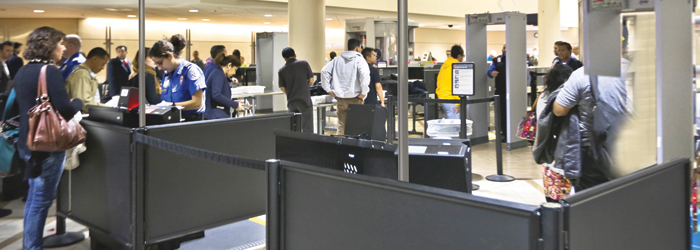Queues and airports go hand in hand. From ticketing to security to boarding, there is practically no way for a passenger to avoid a waiting line at an airport. While 2014 had 3.3 billion passengers taking flight, the International Air Transport Association (IATA) predicts that this number will double over the next 20 years. The passenger experience is paramount, and queues are a major part of traveler encounters. By focusing on the success of airport queues, the entire footprint of an airport can be improved and create happier and more satisfied travelers. Effective queue management can make a difference in five key areas of airport operations:
1. Safety and compliance
No traveler gets on a plane these days without at least giving a few seconds of thought to their safety. But the routes to the plane itself must be monitored carefully too – safety and compliance concerns are part of the passenger journey from start to finish, including queuing. TSA is obligated to safely move a designated number of passengers through their checkpoints per hour – only close monitoring can make this step as efficient and convenient as possible. Key performance indicators and requirements set in service level agreements with regulatory authorities, airlines, and handling agents must also be maintained by airports. Properly built and finely tuned queues can meet these parameters and enhance safety and compliance in many ways, including: preventing large idle crowds from forming and impeding traffic flow in and around the queue, especially in case of an emergency; easing passenger stress and frustration and therefore putting the damper on unrest among travelers in the queue; and ensuring that passengers stay in designated safe areas whether in or around the queuing area.
2. Passenger flow
The last thing any airport wants is for a cluster or crowd of passengers to form in any area, reducing the quality of passenger flow or creating stress among those gathered. Queues that are built thoughtfully and are carefully monitored can keep passengers moving from place to place throughout the airport, preventing bottlenecks and keeping wait times to a minimum. The overall health of airport operations is evidenced by the quality of passenger flow.
3. Staff productivity and resource optimization
Airports employ a lot of people, and making good use of these resources is enhanced by well-managed queues. Greater service efficiency leads to better passenger flow, and when resources are in the right place at the right time, service is optimized and downtime is minimized, for passengers and service agents alike. These allocations are enhanced by electronic queuing methods which facilitate traveler hailing and re-queuing, and intelligent queue management technology that can predict traffic volume and flow across queues.
4. Dwell time in retail areas
Airports are about getting people from Point A to Point B, but sometimes there are places in between worth stopping for, and passengers are happy to have the opportunity to do so. A JD Edwards study found that passengers "delighted" with their airport experience spend an average of 45 percent more money than "disappointed" passengers. One of the goals of quality queue management should be to increase dwell time in retail areas – but if passengers are rushing to their gate because of slow ticketing or long security checkpoint lines, they won’t have the time or desire to spend money in the tempting retail areas of the airport. Moving passengers seamlessly into the retail-oriented areas of the airport should be high on the list of airport managers and queue managers.
5. Passenger satisfaction
Ultimately, good queue management is about increasing passenger satisfaction. Many travelers dread the thought of navigating through an airport and its many waiting lines. But when a passenger has a good airport experience, according to DKMA, they’re more relaxed, spend more money, and are more likely to choose that airport again. Many airports are trying to become destinations in and of themselves, offering passengers amenities like free WiFi, spas, gyms, and attractive architectural details. If finely tuned queues don’t get them to these areas of the airport fast enough, passenger satisfaction will dip. Travelers always have options about which form of transportation they choose to get them to their destination. Airports are increasingly competing with each other and alternative forms of transportation. Customer loyalty can be improved by looking to airport queues about the health of your airport operations and passenger satisfaction. Learn more in in our latest guide, The Passenger Experience: Managing Crowds, Decreasing Wait Times, and Improving the Passenger Journey.










